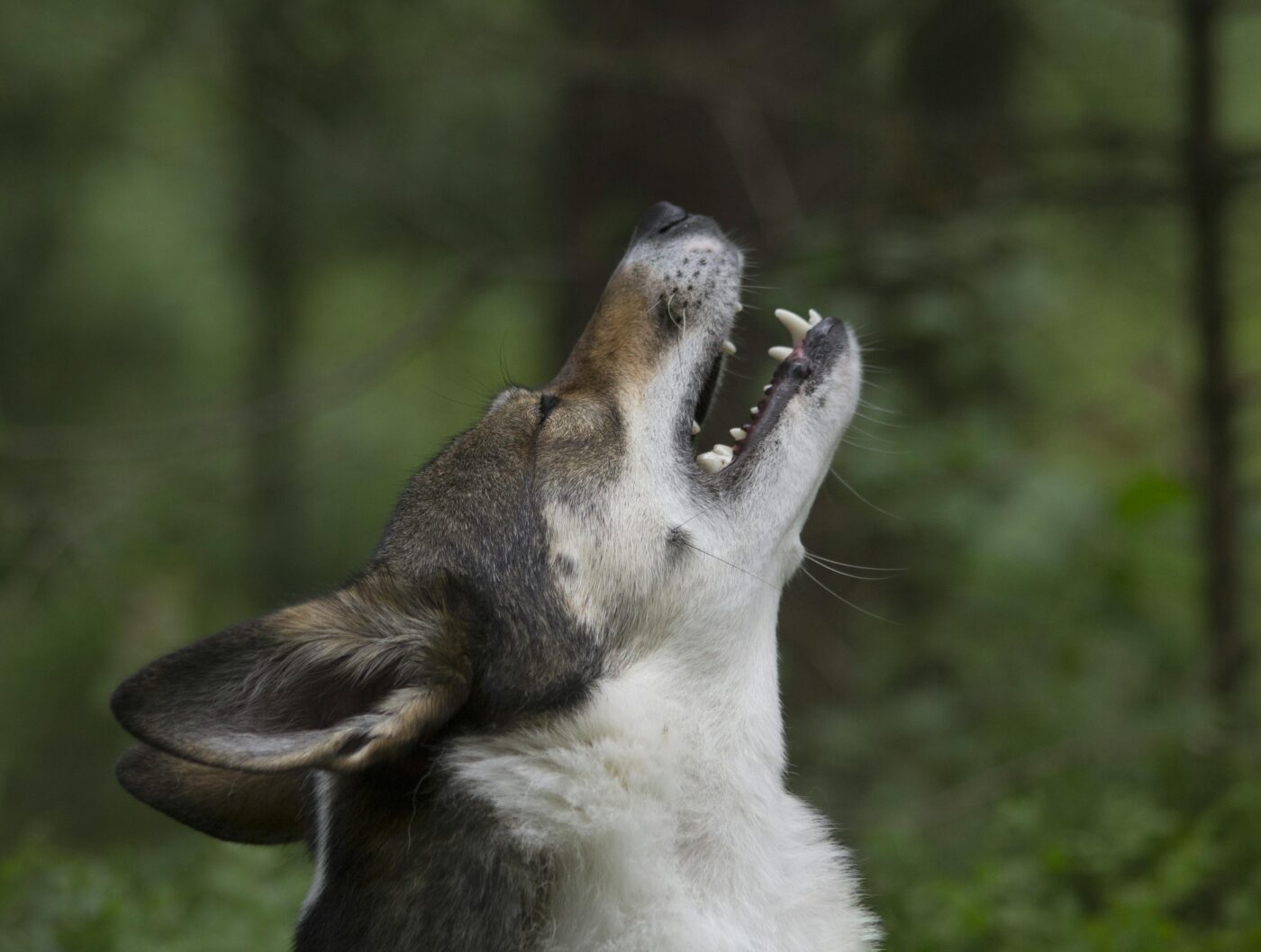 Shutterstock
Shutterstock
When dogs hear a siren, many instinctively lift their heads and let out a howl, which often puzzles dog owners. While it may seem like a straightforward response to loud noise, the reasons behind it are more complex. From deep-rooted evolutionary instincts and communication to environmental factors, there are various explanations for this behavior. Dogs’ reactions to sirens can provide fascinating insights into their natural tendencies and social behaviors. Understanding these reasons helps dog owners interpret their pets’ actions and the deeper instincts that drive them.
Evolutionary Connection to Wolves
 Shutterstock
Shutterstock
One of the most well-known reasons dogs howl at sirens is their evolutionary connection to wolves. Wolves use howling as a form of long-distance communication, allowing them to communicate with their pack members over vast distances. Since domestic dogs share a common ancestor with wolves, this instinctual behavior remains in many breeds today. When a dog hears a siren, the high-pitched sound may mimic the frequency of a wolf’s howl, triggering the dog’s natural inclination to join in with the sound as if they were communicating with their own pack.
Heightened Sense of Hearing
 Shutterstock
Shutterstock
Dogs have an exceptional sense of hearing, much stronger than humans. They can detect sounds at higher frequencies and farther away than we can. Sirens, with their high-pitched wail, fall within a dog’s range of sensitive hearing. The intensity of the sound may be uncomfortable or startling, prompting the dog to howl in response. This reaction can be seen as an attempt to process or respond to the sudden noise. Howling might help the dog cope with the overwhelming sensory input, acting as a release for the auditory stimulation.
Territory Protection
 Shutterstock
Shutterstock
Dogs are naturally territorial animals, and howling can assert their presence or warn others away from their territory. When dogs hear a siren, they may perceive it as a potential threat entering their environment. In response, the dog howls to mark their territory and signal that they are present. This behavior can be especially pronounced in breeds with strong guarding instincts, such as German Shepherds or Rottweilers. Howling serves as a protective measure for these dogs, alerting both the perceived intruder and their human family that something is approaching.
Seeking Pack Communication
 Shutterstock
Shutterstock
In addition to marking territory, howling is also a way for dogs to seek communication with their pack, whether that pack is other dogs or their human family. When a dog hears a siren, they may be trying to communicate with the sound, believing it to be a call from another ” pack member.” Howling serves as a way for the dog to respond to what they perceive as a distant call, reinforcing their connection with their social group. This behavior is particularly common in breeds closely related to wolves, such as Huskies and Malamutes.
Attention-Seeking Behavior
 Shutterstock
Shutterstock
Some dogs howl at sirens to get attention from their owners. If a dog learns that howling at a siren results in attention, even if it’s just a glance or a laugh, they may continue the behavior to engage with their owner. Dogs thrive on social interaction, and howling at a siren can become a way for them to initiate communication or play with their human family. In these cases, the howling is less about the siren and more about the dog’s desire for attention and interaction.
Anxiety or Stress Response
 Shutterstock
Shutterstock
Howling at sirens may be a sign of anxiety or stress for some dogs. Loud, unexpected noises like sirens can overwhelm dogs, particularly those more sensitive to their environment. Howling can be a way for the dog to express their discomfort or fear in response to the siren. Dogs prone to separation anxiety or noise phobias may be more likely to howl at sirens to cope with the stress. In these cases, howling releases the dog’s nervous energy and is a way to self-soothe in a stressful situation.
Mimicking Human Behavior
 Shutterstock
Shutterstock
Dogs are highly observant creatures, often mimicking the behaviors of their owners or other household members. If a dog sees that their owner reacts to sirens by paying attention to them or making a noise, the dog may mimic this behavior by howling. This imitation can also happen if a dog lives in a multi-dog household and hears other dogs howling at sirens. The dog may join in with the howling simply because it sees others doing it, reinforcing the behavior through social mimicry.
Breed-Specific Traits
 Shutterstock
Shutterstock
Certain dog breeds are more predisposed to howling than others. Breeds closer to their wolf ancestors, such as Alaskan Malamutes, Beagles, and Huskies, are more likely to howl in response to sirens. These breeds naturally gravitate toward vocal communication, and howling is a significant part of their behavioral repertoire. Even though all dogs can howl, these breeds are more likely to exhibit this behavior due to their genetic predisposition. For owners of these breeds, howling at sirens may be common.
Response to High Frequencies
 Shutterstock
Shutterstock
Sirens produce a high-frequency sound that can irritate or catch the attention of a dog’s sensitive ears. Dogs can hear frequencies much higher than those detectable by humans, and sirens often fall within this range. The high-pitched wail of a siren may cause discomfort or agitation in some dogs, prompting them to howl to respond to the sound. In this sense, howling serves as a way for dogs to vocalize their reaction to the irritating frequencies produced by the siren.
Pack Mentality and Group Behavior
 Shutterstock
Shutterstock
Dogs are pack animals, and howling is a social behavior that helps strengthen the bond between pack members. When a dog howls at a siren, they may be responding to what they perceive as a call from another member of their pack, even if that “member” is the distant sound of a siren. Howling reinforces their connection to the pack, signaling they are present and ready to respond. This instinctual behavior is deeply rooted in a dog’s social nature, and it explains why some dogs howl in response to sirens, even when they are alone.
Curiosity and Exploration
 Shutterstock
Shutterstock
Dogs are naturally curious creatures and often investigate unfamiliar sounds or objects. The sound of a siren may trigger a dog’s curiosity, prompting them to howl to explore or respond to the new noise. Howling can serve as a way for the dog to vocalize their interest or confusion about the sound, much like barking at an unfamiliar object. In this case, howling is less about communication and more about the dog’s natural curiosity and desire to understand the world around them.
Instinctual Response to Disturbances
 Shutterstock
Shutterstock
Howling at sirens can be an instinctual response to perceived disturbances in the dog’s environment. In the wild, wolves and other canines howl to alert the pack to potential dangers or to communicate over long distances. Domestic dogs retain this instinct; a siren may trigger their natural response to vocalize when something disrupts their environment. Howling serves as a way for the dog to acknowledge the disturbance and signal to others that they know it. This instinctual behavior is part of the dog’s deep-rooted connection to their wild ancestors.
The Mystery Unraveled
 Shutterstock
Shutterstock
The phenomenon of dogs howling at sirens is a fascinating blend of instinct, communication, and environmental triggers. Dogs have multiple reasons for this behavior, whether it’s a response to their evolutionary roots, a desire to communicate with their pack, or simply curiosity about a new sound. Understanding these explanations can help dog owners better interpret their pet’s reactions to sirens and appreciate canine behavior’s deep, instinctual nature. While the mystery may never be fully solved, the connection between dogs and their ancestral howls intrigues and captivates us.

 1 month ago
12
1 month ago
12


















 English (US) ·
English (US) ·